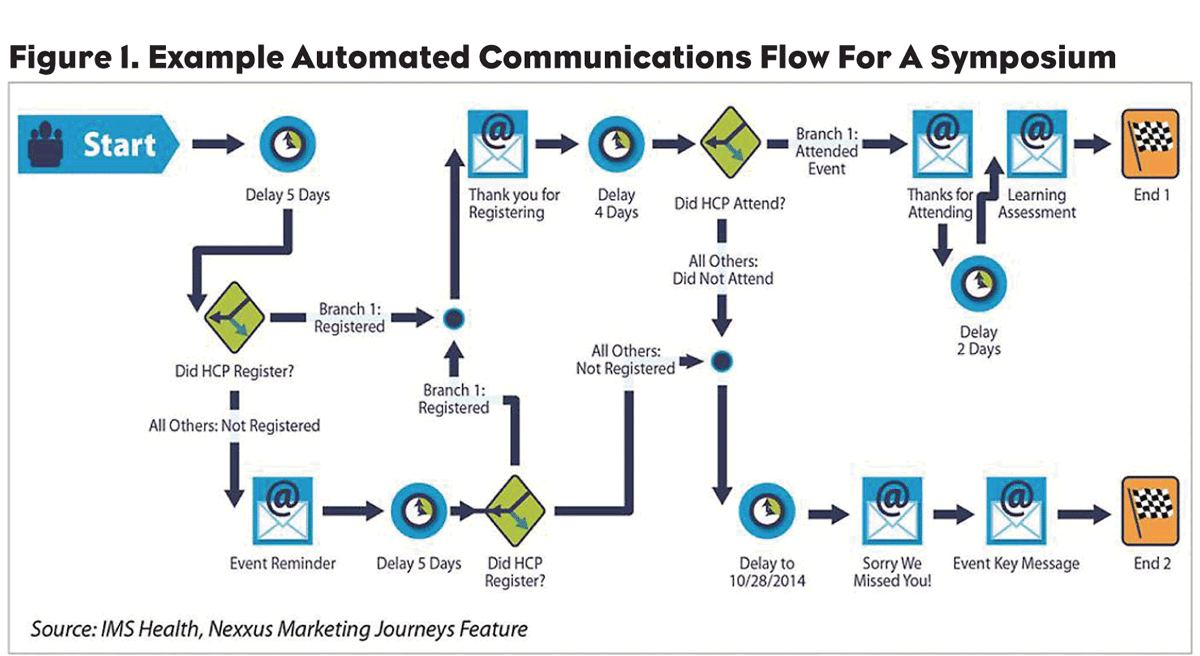Effective multichannel marketing (MCM) to healthcare professionals (HCPs) is about orchestrating a range of personal and non-personal delivery channels—web, phone, sales visits, email, mobile, direct mail and so on—to engage them over time via a constructively cumulative set of interactions. The aim is to ensure that the right message, in the most appropriate format and at the right frequency (so they don’t get tagged as spam), reaches the customer at a time that is both convenient and most likely to provide a valued experience or service.
While the majority of life sciences companies have put significant focus on building multichannel capabilities over the past few years, many still have some distance to go to achieve their desired end‑state. To accomplish this, life sciences companies can follow a process of “Automate, Learn and Adapt,” as explained below, to intelligently and efficiently engage with their customers.
Automate
To effectively manage customer interactions across channels, life sciences companies need to automate certain processes that may have been manual or fragmented in the past. These include:
1. Data collection: Most companies do not have processes in place to fully integrate their customer information, even though a complete view of customers is a key foundation of effective MCM. To work more effectively means ensuring automated linkage of all key sources to a central hub, as well as developing a data governance process that includes policies for compliant data sharing. This is the only way a 360° view of customer behavior can be achieved and, crucially, maintained.
2. Customer preference management: Likewise, many companies lack a comprehensive approach to tracking and managing customer communication preferences. They may either manage preferences ad hoc by individual program or use a blanket opt-out approach across all content and channels that effectively tells the customer, “You either get everything from us or nothing.” Automating and centralizing preference tracking across all program elements and channel types enables a more nuanced view of what each customer is interested in and how they want to interact.
3. Campaign journeys: A central tenet of effective MCM is being able to plan and deliver messages across all channels to ensure a cohesive customer experience and strong follow-through over time. Having an intelligent automated approach to executing “campaign journeys” for each customer allows brand managers to orchestrate the volume, sequence and cadence of touch points across carefully structured pathways (Figure 1).
Learn
A hallmark of effective marketers: They drive steady improvement over time. Once a brand establishes a solid strategy into the automated execution described above, the next task is to learn by assessing programs operating in the real world.
1. Structure and oversight: An effective MCM program depends on a 360° perspective of customer interactions and preferences. To make sense of the data, however, teams need an owner with oversight across the various programs and channels to understand the full customer experience. It is vital that marketers have an overall view of the entire campaign for a particular brand and, if applicable, the different indications that may be marketed.
2. Testing: Establishing a strong technological and structural foundation for MCM is crucial. This forms the basis for developing the capacity to assess effectiveness, refine options and adapt methods over time. This should include regular A/B testing on sample cohorts of customers to improve message effectiveness, the relative impact of offers, even the tone and language of each communication. Taking advantage of automated tools and building in a regular process that enables A/B testing can inform decisions and support innovative combinations of promotion and engagement.
3. Field integration: The field force is an essential component of multichannel campaigns, remaining the most influential channel in the promotional mix. It can play a strong role in facilitating access to other channels providing services and content while also serving as a valuable resource to understand the qualitative attributes of your campaigns. Knowing how a customer felt about a communication is crucial insight often not readily found through the quantitative response metrics.
Adapt
Once you have the right tools and processes in place to collect insights from real world customer behavior, the next step is to quickly adapt campaigns to the lessons learned. Key success factors for the adapt phase include:
1. Access to data: Identifying improvement opportunities quickly has been a major challenge in the past because life sciences marketers have not had fast, direct access to campaign performance data. It may not have been accessible at all or could only be accessed at a significant lag by submitting a formal request to an internal data steward or even an external third party. Any potential for adjustments or optimizations often fade as the delay in obtaining the data typically stretches for weeks.
Moving from retrospective to predictive and dynamic analysis allows activity to be targeted based on insight. Cloud-based tools provide web‑based dashboards with live data on campaign performance accessible to key stakeholders like centralized multichannel marketing groups, brand managers, analytics teams and agencies.
2. Field integration: As in the learning phase, field integration is essential for adapting programs to achieve multichannel excellence. This can take the form of triggering rep follow-up when customers are not responsive at a given step in the campaign journey, as well as reps triggering non-personal tactics. With the right integration of sales and marketing systems, companies can enable reps to trigger pre‑approved multichannel follow-up activities specific to their particular customers based on what they learn in a call.
3. Focus on the customer: Adaptation is all about getting results from the 360° perspective of the customer and the capabilities established to operate effectively. At a fundamental level, MCM is a combination of three basic elements: Customers, content and channels (including the rep). The central and most neglected component of this process is invariably the customer. So while a lot of conversation about multichannel focuses on the technology or the channel, it is important to maintain a focus on the needs, interests and attitudes of the customer in both designing your outreach and identifying improvements over time.







